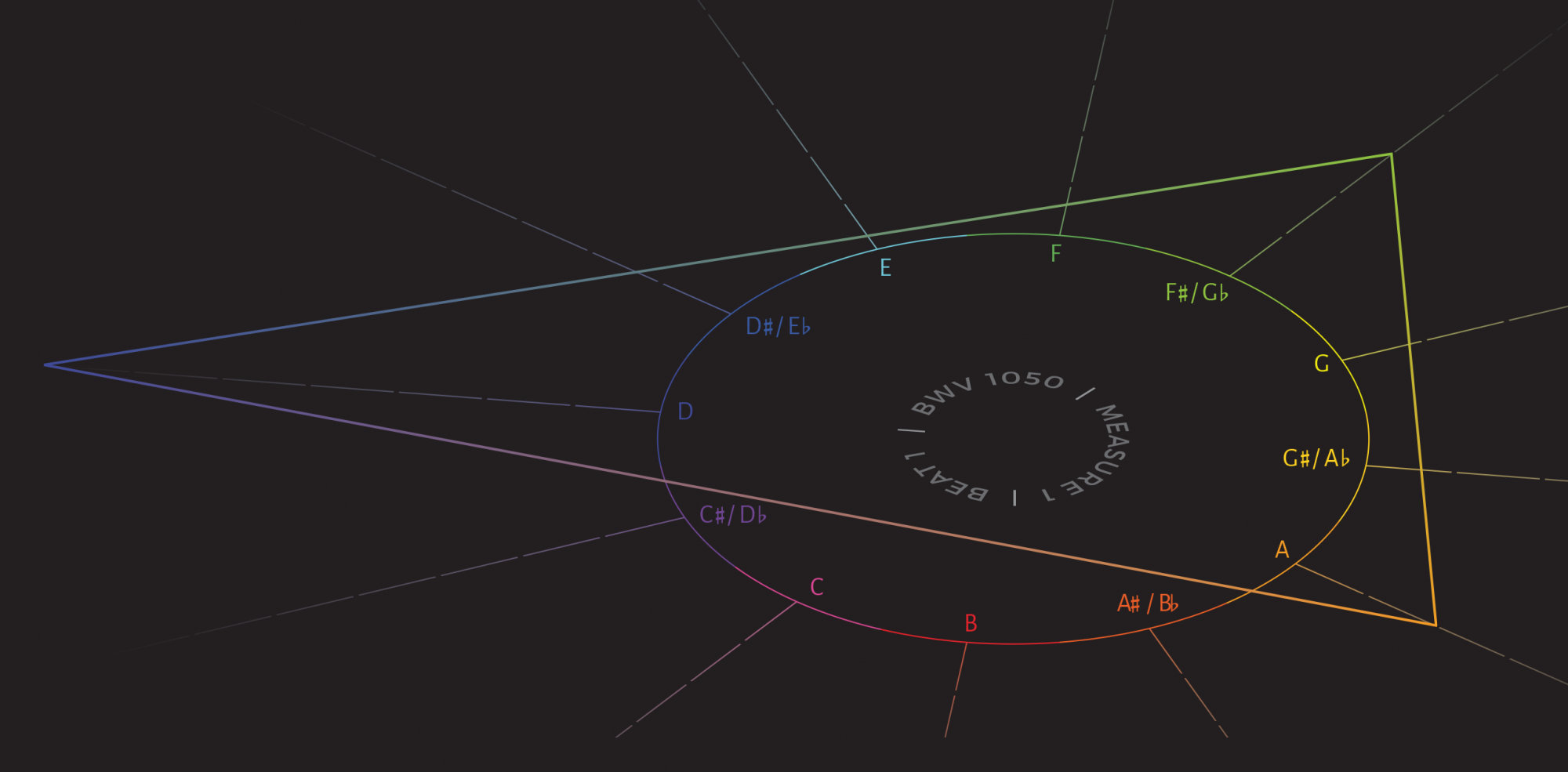Matthew Bilik
Abstract
This paper explicates how the sensation of two active keys, known as key duality or tonal pairing, often results as disjunction between the melody and bass in the music of Gabriel Fauré and Maurice Duruflé. In Fauré’s late chamber works, a distinct type of key duality arises not as a juxtaposition of two keys but from the superposition of two. Fauré’s use of key duality is mirrored by other twentieth-century French composers; Duruflé echoes a similar type of duality, albeit to a greater extent. Employing motivic segmentation and voice-leading analysis, I adapt the research of Peter Smith (1997 and 2013), Kaminsky (2004), and Ferrandino (2022), among others, to illustrate how the sensation of two tonal centers emerges when the tonal outline of a melody or bass projects its own center separate from that of other voices. Attention to outer voices sheds light on Fauré and Duruflé’s tonal sleight of hand—a topic many have noticed but few have illuminated.
Keywords and Phrases: Fauré, key duality, disjunction, Duruflé, tonal pairing
As a preliminary demonstration of key duality in Gabriel Fauré’s late chamber works, I present an excerpt from the Violin Sonata no. 2 (1916) with the bass line omitted in Example 1. Survey the B major melody with its emphasis on $$\hat{5}$$ (

However, the excerpt eschews a tidy B major interpretation due to a rogue bass. Example 2 presents the passage in its entirety, now including the bass which outlines

This article explores how similar instances of duality between keys occurs as a disjunction between the melody and bass in four other chamber pieces by Fauré: the Piano Quintet no. 2 (1921), Cello Sonata no. 2 (1921), Piano Quintet no. 1 (1906), and Piano Trio (1923). It concludes with the Requiem, op. 9 (1947) by Duruflé, who heightens the sensation of key duality. In one situation, the tonal profile of the melody is so robust that it furnishes its own center separate from the accompaniment.1 When this arises, the composer may elevate the structural role of the upper parts to convey a distinct center or key. However, in the other circumstance, the tonal fingerprint of the bass suggests a second tonic layered beneath the other. That is, the bass outlines a center or key separate from that of the upper parts. I recast theories of tonal pairing and melodic-harmonic divorce that, while abundant, have not been combined in this type of repertoire. On the other hand, I maintain that key duality in Fauré and Duruflé often proceeds from a divorce between tonal profiles of the melody and bass—a perspective that has been largely undertheorized outside of popular music. As preface to my analyses, a brief overview of tonal pairing and melodic-harmonic divorce unfurls below.
Tonal Pairing and Stratification
Previous theorists have investigated the sensation of two simultaneous tonics in play, or tonal pairing. Known also as the “double-tonic complex” according to Robert Bailey (1985), this phenomenon typically refers to two active tonics a third apart, juxtaposed but existing on an equal structural level. Peter Smith (2013) locates prescient instances of tonal pairing in common practice Germanic music, revealing how 5–6 exchanges at higher levels create hierarchical ambiguity between keys a third apart (e.g., a tonic and its submediant). Viewed in this fashion, tonal pairing may be the consequence of shifting tonal focus within a 5–6 exchange.2 Other extant literature on key duality focuses on a single composer. Boyd Pomeroy (2004) tracks the severity of dueling tonics in Debussy, while Ellen Bakulina (2018) invokes key duality when talking about “proto-harmonic” structures in Rachmaninoff.3 Joseph Straus (1986) traces third-related tonics in Stravinsky around a shifting tonal “axis.” Straus’s work on tonal stratification is applicable to the present study—chiefly, his tenet that for a tonal axis to exist, it must be stated outright as a verticality.4 This is precisely what ensues in Example 2 and the following analyses where the chord at the beginning or end of a phrase is a seventh chord that fuses two dueling tonics into one. I also subscribe to the idea of two active tonics of equal weight, frequently related by thirds. In Fauré’s late oeuvre, the melody or upper (SAT) parts often express a key a third higher than the key expressed by the bass.5 In addition, I view these individual tonal centers as superimposed rather than juxtaposed, in the vein of polytonality.6I resort to the term key duality rather than double-tonic complex, because in some excerpts the melody or bass alludes to tonal relationships (e.g., i-v) in a key.7 That said, many passages do simply involve a double-tonic complex solely by means of two tonics unfolding.
Matthew BaileyShea (2007) removes the haze surrounding the double-tonic complex by categorizing the salience of a dual tonic.8 In the first category, “vacillation between two keys” is more of a juxtaposition than a simultaneous overlapping of two keys. This is different from the second category, “tonal collision,” where keys may substitute for one another or coincide at the same time (194).9 The third category contends that this fusion of dual tonics can act as structural tonic, like the conflation of a C major and A minor tonic into an
Drew Nobile (2020) contrasts tonal pairing with the double-tonic complex, although in both neither dual tonic is superior to the other. Tonal pairing, he writes, involves oscillation between two keys—a “juxtaposition of two monotonal frameworks”—that may incite tonal conflict between two incompatible keys (207).11 The double-tonic complex, instead, is more of an abstract tonality that conjoins two tonics to create a new governing tonality. Nobile defends this more contentious view of tonality as a conflation of two keys, explaining that in the double-tonic complex, neither key is dissonant with the other because they stem from the same abstract, fused tonality; the four-note sonority (such as an
Tonal stratification, or the layering of tonal centers separated by register and texture, is indirectly related to key duality. Duality may contain vestiges of tonal stratification, but stratification is by no means a requirement of duality. Specifically, tonal stratification evokes the concept of polytonality via superimposed tonal strata. In his work on Ravel, Peter Kaminsky (2004) reframes the presence of polytonality, arguing that listeners “prioritize” one tonal center at a time based on the surrounding musical context. He describes how the bass may either 1) assimilate the dissonant upper voices into one tonal center or 2) elicit a “dual prioritization” when the tonal weight of the treble voices establish a primary or secondary center.13 Other authors, like Philip Rupprecht (1996), allow stratification to signify a tension (in his words, a “discrepancy”) between two “focal pitches,” not necessarily two triads or keys (312 and 320).14 To him, how the voices are registrally delineated becomes a principal factor in the strength of strata. Such sensitivity to texture has great payoff in Fauré and Duruflé; the fact that the outer voices partake in duality makes tonal disjunction more prominent.15
Melodic-Harmonic Divorce
Pulling apart the tonal layers of music has elucidated opaque or dissonant harmonic phenomena, especially those in pop and rock. Authors have detected a melodic-harmonic divorce in popular music,16 where the “independence or stratification of musical layers” generate unusual dissonances (de Clercq 2019, 273). As David Temperley (2007) and Nobile (2015) point out, melody and harmony each have potential to express a different level of formal or harmonic structure in diverging ways.17 Although more common in the popular music sphere, a general theory of separate tonal layers need not be style-bound or repertoire-specific. I do not advocate drawing false parallels between popular music and that of Fauré and Duruflé, let alone believe in committing Nobile’s categories of hierarchy, syntax, and loop divorce to classical music. Nevertheless, we can observe a similar type of disjunction between musical layers in Fauré and Duruflé that facilitates varied shadings of the passage depending on the tonal strength of each stratum. In Example 2, we may hear B major or
My present work more closely mirrors that of Matthew Ferrandino (2022) and his idea of multi-centric complexes in pop and rock. In these complexes, diverse performing forces (i.e., bass, singer/melody, and guitar/keyboard) may imply a tonal center distinct from the others. His example from “Dreams,” by Fleetwood Mac, ensconces two tonal streams: an F major bass line that lands on F every two bars and an A minor—or even C major—vocal line which begins each phrase on A or C while accentuating the pitches A, C, and E.19 However, like Nobile, he does not profess that listeners hear both tonal threads but acknowledges how they might shift from one to the other (30). In his examples as well as mine to come, stratification imparts either 1) a sense of ambiguity of one center or 2) a fluctuation of competing centers. My choice of word, “disjunction,” hopes to highlight the autonomy of the melodic and bass layers even more. In fact, such musical agency is not limited to outer voices; I show how inner voices assert their own musical agency at times, strengthening the role of the bass or melody in the interpretation. I take my definition of agency from Edward Klorman (2016), who defines multiple agency as an interaction between independent musical roles or ideas, enacted by performers who influence the actions of one another in a “seemingly spontaneous” manner (122).20
Role of Bass
The ebb and flow of disputing tonal centers raises questions about the function and, thus, the structural level of each voice. For instance, if the soprano melody projects the leading key, the bass may function as color tones. In these cases, we might view the bass as the added sixth of the chord, appearing a third below the root of the structural triad.21 For example, an
It stands to reason that the bass can take a front seat as harmonic driver or a back seat as harmonic color. In the first case, the bass conforms to expectations of a tonal progression via a syntactical phrase: a T-S-D-T phrase model or at least a T-D-T outline.24 In the second case, using the bass for color rather than as a vehicle for harmonic function turns a norm of tonality on its head; that is, the motives and upper parts point to a tonal center while the bass simply adds textural density or harmonic color.25 A broader issue of chord recognition and overall key finding concerns voice doubling and voice leading. For instance, unconventional voicings may mask the identity of a chord or key. Due to oscillating centricity between two members of a chord (e.g., the root versus the third), the listener may discern more than one key. Part of this is an outgrowth of reversing the hierarchy of root positions over inversions, which may lead to tonal allusions.26 Frequently, Fauré reinterprets the first part of a cadential $$^{6}_{4}$$ as a consonant tonic
In Fauré’s and Duruflé, key duality occurs as a disjunction between the melody and bass.27 This transpires when a melody imparts a tonal center or key—usually via melodic unfolding of a structural harmony—that is dissimilar to the accompaniment. Conversely, if the bass espouses a strong tonal profile different enough from the melody, it can imply its own concurrent tonic.28 In this case, the bass might establish a center or key separate from that of the upper parts.29 In the first few examples from Fauré, the relationship between stratified centers is a third, which may be explained via a contrapuntal 5–6 exchange. In fact, nearly all the following examples comprise key duality of third-related keys; only the final selections by Fauré and Duruflé feature disjunction of melody and bass at an interval other than a third. In addition, the final analyses widen the scope of the paper to include another French composer, Duruflé, who mirrors Fauré’s application of key duality but exemplifies larger-level manifestations of it.
Fauré: Piano Quintet no. 2, op. 115 (1921)
Example 3 depicts a C minor melody from the first movement of Fauré’s Piano Quintet no. 2. Three musical factors gird the sense of C minor: the prominence of tonic and dominant pitches (C and G), the C-C range of the melody, and the ephemeral G dominant in m. 194. While there is dorian inflection from the
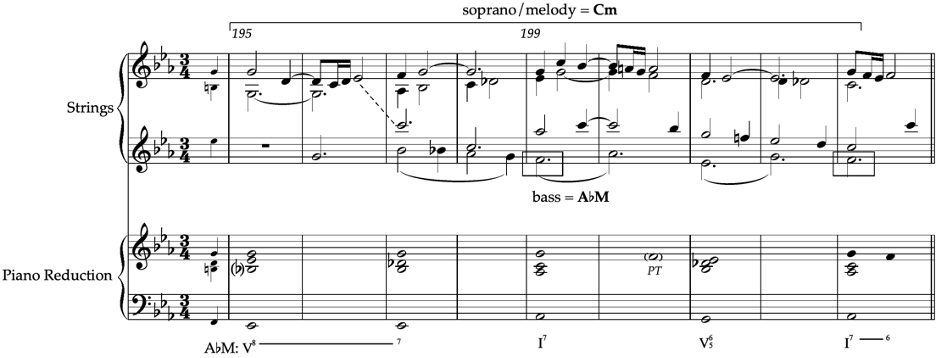
Key duality resurfaces in Example 4 from the second movement, where the melody unfolds a D minor sonority above a bass that articulates
The D minor triads in every other measure stagger and weaken a fauxbourdon $$^{6}_{3}$$ sequence, thereby foregrounding D minor despite the momentary 5–6 exchange in m. 45. The logic behind the passage is clearly $$^{6}_{3}$$ planing, but the surface presentation rubs against this schema. For example, the chord in m. 48 could be a continuation of the $$^{6}_{3}$$ sequence with the chord
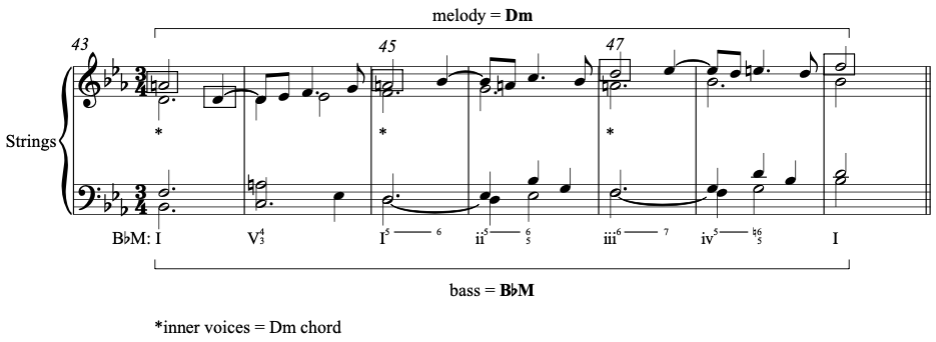
The fluidity between $$^{6}_{3}$$ and $$^{5}_{3}$$ voicings above a stepwise bass, like in Example 4, invites a Rule of the Octave (RO) approach.34 Drawing on the work of Smith (1997) and his ideas of motivic $$^{6}_{3}$$ chords,35 Gilad Rabinovitch (2023) demonstrates how Fauré enjoys “conflating $$^{6}_{3}$$ and $$^{5}_{3}$$ sonorities with one another in positions across the bass scale where the other sonority is expected” (Rabinovitch, 59). Guided by a RO framework, he maintains that one reason for harmonic ambiguity springs from Fauré’s constant reinterpretation of scalar bass segments.36 This is evident in the substitution of $$^{5}_{3}$$ for $$^{6}_{3}$$ chords, which tempts us to hear the former as conveying the more stable center; in Example 5, the substitution of a root-position E minor triad in m. 91 for a C major one injects conflicting information. Even if C major is ingrained from the earlier I$$^{6}$$ chords, we might hear a tug-of-war due to the stronger $$^{5}_{3}$$ voicings of the ancillary E minor key. In parallel passages to come, $$^{5}_{3}$$ triads freely supersede $$^{6}_{3}$$ ones.
Fauré: Cello Sonata no. 2, op. 117 (1921)
Chamber works from this period spotlight how deft 5–6 exchanges tip the balance between two keys related by third. Example 5, from the slow movement of the Cello Sonata no. 2, shows the piano bass and cello melody partaking in 5–6 exchanges that toggle between C major and E minor. Over mm. 92–94, the soprano motive points to C major (G-C-G) as the bass motive outlines E minor (E-B-E). Throughout the global C major environment, E minor interjects in mm. 86 and 91 as well. The Roman numerals favor the former due to the constant restarting on
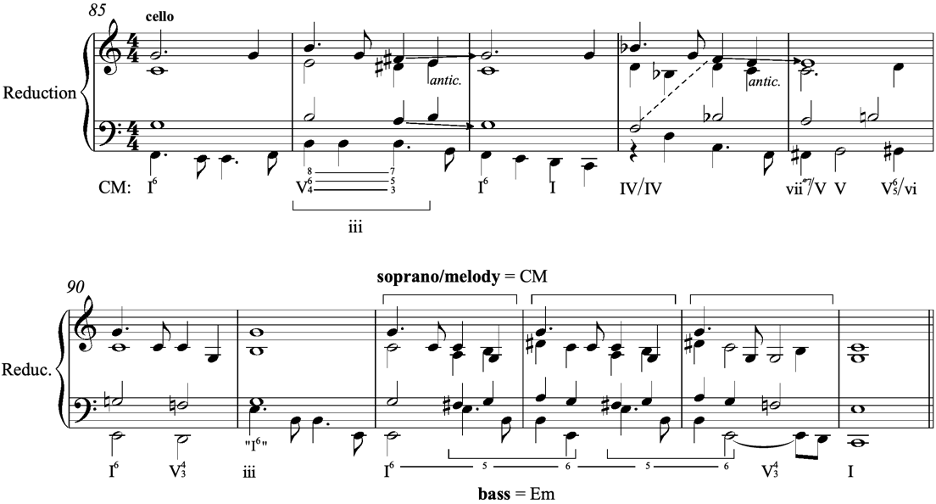
In the third movement, Example 6 illustrates how two disparate tonal strands imbue the music with key duality, often in tandem with contrapuntal 5–6 substitutions. Over mm. 64–71, the soprano melody hints at an
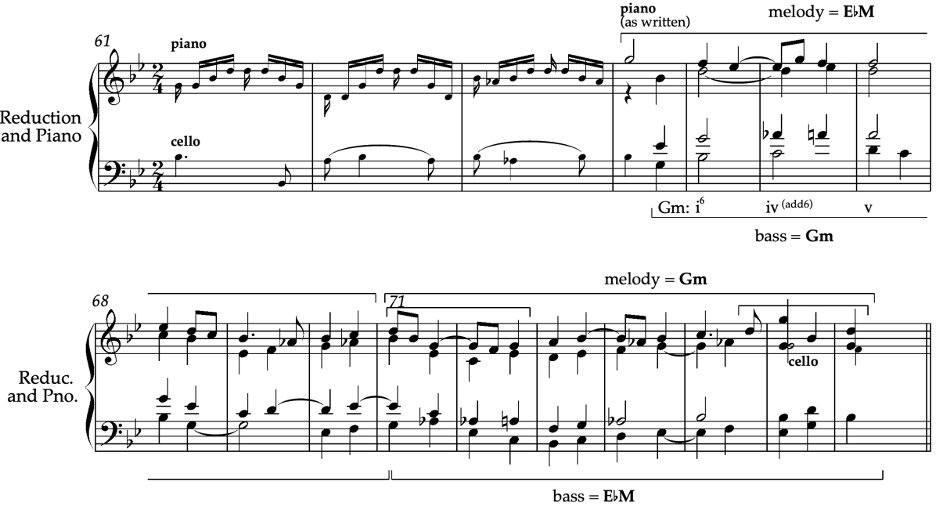
Fauré: Piano Quintet no. 1, op. 89 (1906)
The final movement of the Piano Quintet no. 1 in Example 7a portrays how a B minor melody resists the D major center of the bass due to changing surface emphasis on A and B. The harmonization of the pitch B in mm. 1–2 with
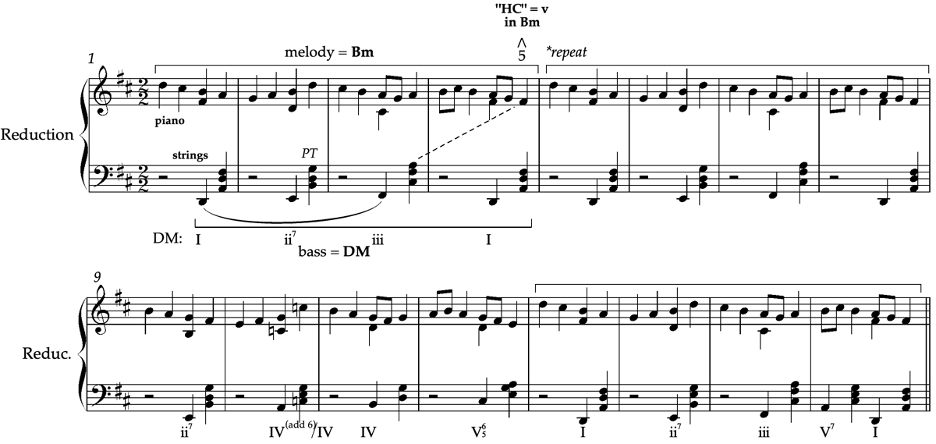
The wobble between D major and B minor persists through the movement; B minor reappears with increasing fervor, inhabiting the ear of the listener more and more. In Example 7b, mm. 49–53, Fauré paints the earlier motive with bolder B minor, amplifying the feeling of half cadence on
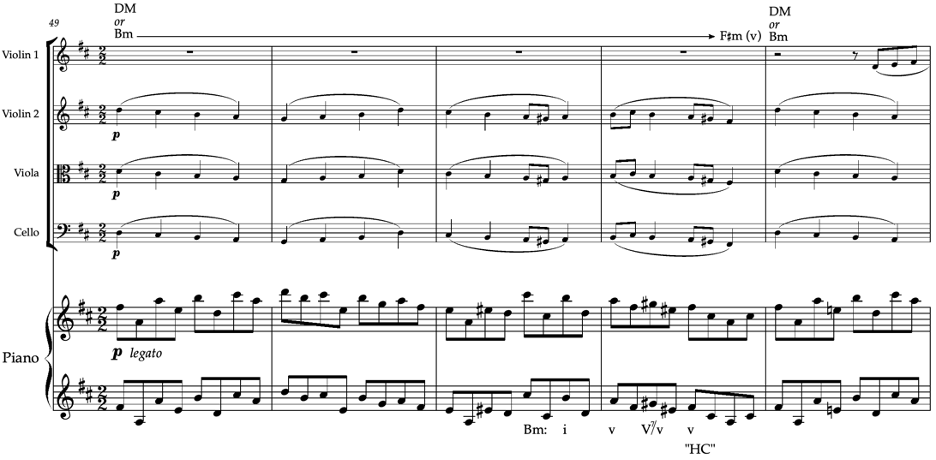
Comparable instances of key duality over longer swaths of music commence in the third movement of the Piano Quartet no. 2 (1887), in Example 8a. Although much earlier, this vignette also exhibits a tension between two keys related by third,
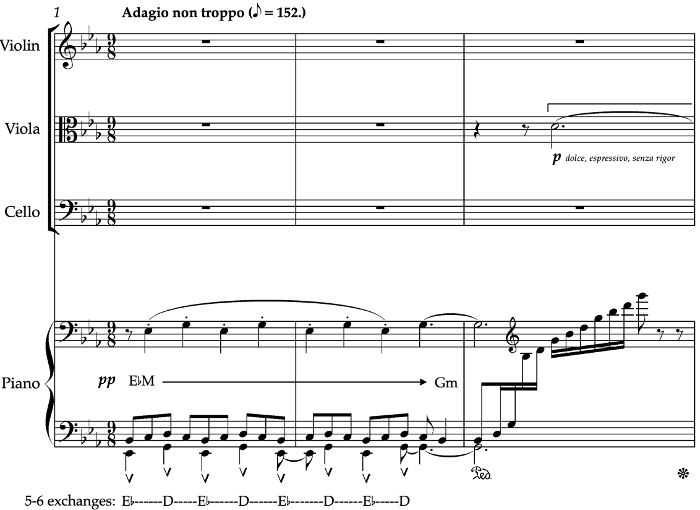
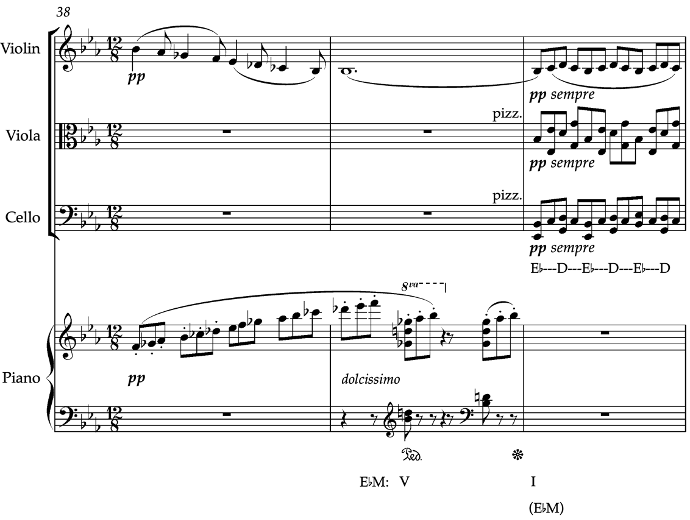
Fauré: Piano Trio, op. 120 (1923)
In Example 9, the finale of the Piano Trio announces key duality at the outset, except now the interval of disjunction is no longer a third but a fifth, as the cadence of the consequent (mm. 10–12) answers that of the antecedent (mm. 7–9) a perfect fifth lower. Tonal ears may readily grasp the underlying period structure. The key signature and tonal skeleton of the melody evince D minor, embodied in the first cadence on the dominant (A) and the second cadence on tonic (D). Yet the bass confronts this tonic with a competing G minor tonic. That is, the D in m. 8 to the terminal G in m. 12 implies G minor—a familiar v-i tonal structure. Strengthening a G minor reading is the
The merging of D minor and G minor casts an unmistakable modal hue. The outcome of key duality for the listener may be the perception of modalism—a trait so often ascribed to Fauré’s works.41 With Kaminsky’s ideas in mind, we may prioritize the D minor melody or the G minor bass, but the simultaneous interaction of the two strata creates a modal synthesis for the listener. For example, I can hear D phrygian at first due to the combination of the D minor melody with the C and
This excerpt attests to the difficulty in analyzing polyphonic passages. Plural function stems from the tonal fingerprint of each voice: is the final chord in m. 12 the D minor tonic (privileging the soprano) or a

The same phenomenon ensues in Example 10, when Fauré presents the melody in canon. Fauré forges his harmony from the layering of motives. There are no block chords; instead, Fauré opts for three distinct polyphonic voices. In a nod to medieval counterpoint, he gives the listener two voices in imitation above a steady “tenor.” The motive engineers much of the dissonance, complicating the passing harmonies in mm. 122–123. While the outer voices and harmonies come together at harmonic goalposts (see measures with Roman numerals), neither are clear en route. For example, the F bass in m. 123 passes up to the following G, while the

The other tonal layers and motivic statements in canon obscure a holistic harmonic analysis but are nonetheless synthesized once again below the staff with Roman numerals. The C minor reading from the bass is reinforced by the tonicized half cadence—the applied
Our last Fauré example, the ninth song of the 1906–10 song cycle La chanson d’Eve, op. 95, “Crépuscule,” stages an unabashed melding of D minor and F major, seen in Example 11. The recurring D minor melody, plucked from his suite Pelléas et Mélisande (“La mort de Mélisande”), coexists peacefully with its D minor context at first, entraining the listener to hear D minor. However, beginning in m. 15, a protruding C pedal sounds in the bass, supporting F major triads (in second inversion) at the beginning and ends of each two-measure phrase. To tonal ears, this harmony suggests a standing on the dominant, C, in F major. Together with the D minor profile of the melody, one may hear the composite harmony as an F major triad with added sixth, D, above.46 Yet affirmation of F major never arrives, and the song ends in D major, the parallel key in which it began. The compound F major/D minor tonic, a
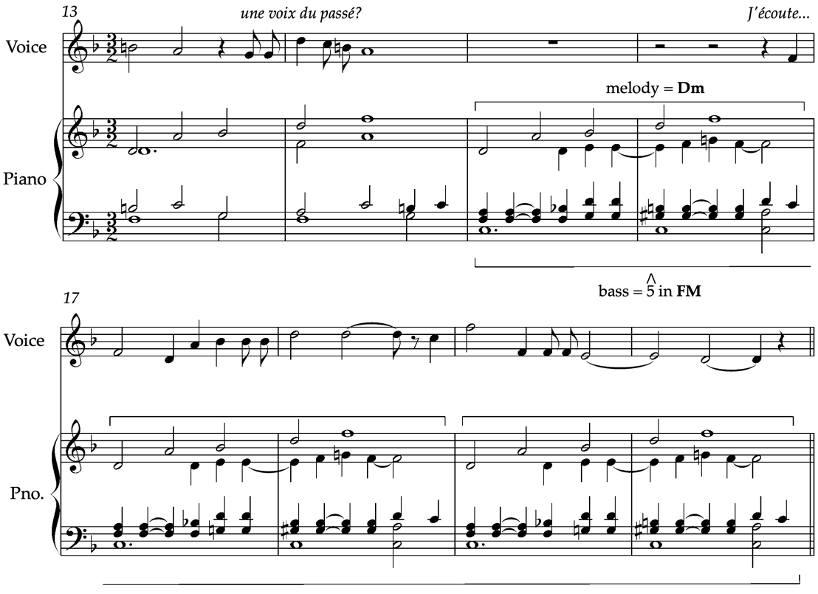
Duruflé: Requiem, op. 9 (1947, rev. 1961)
We have now ventured from BaileyShea’s second category of the double-tonic complex to the third, which also brings us closer to Nobile’s true double-tonic complex characterized by a fundamental four-note tonic sonority. Key duality of this sort in twentieth-century French music comes to a head in the music of Duruflé. Considering Duruflé’s interest in chant reharmonization, it is not surprising that his melodies emit tonal ambiguity between a chant line and its harmony. Although analytical writings on Duruflé have recognized the significance of reharmonization in his works, they have also skirted the idea of key duality, opting to reduce a tonic seventh chord to a structural triad with extensions (Harrison 2016) or view chords as part of an evolving macroharmony (Chiu 2021).47 The end of Domine Jesu Christe, from the Requiem, op. 9, maintains a delicate equilibrium between
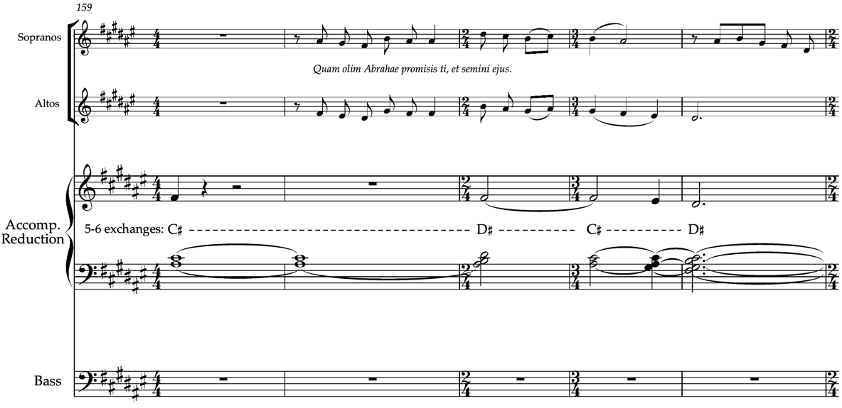
The beginning of the first and fourth movements contain similar occurrences of key duality due to Duruflé’s chant harmonization. These movements are notable for their greater degree of duality. Where Fauré may implement duality for 8–16 measures, Duruflé might indulge in duality for most of a movement. Example 13, the beginning of the Introit, pits a D minor bass against an F major choir.50 The D bass pedal and sustained D/F dyad across bar lines reifies the D center of the accompaniment, while the Fs in the choir at the beginning and ends of phrases (mm. 2, 5, 7, and 11) solidify an F center. At two of these junctures, mm. 5 and 11, the upper voices also fill out the F major triad upon entering. The mingling of these two tonal centers appears in the sixteenth-note arpeggios, which outlines a
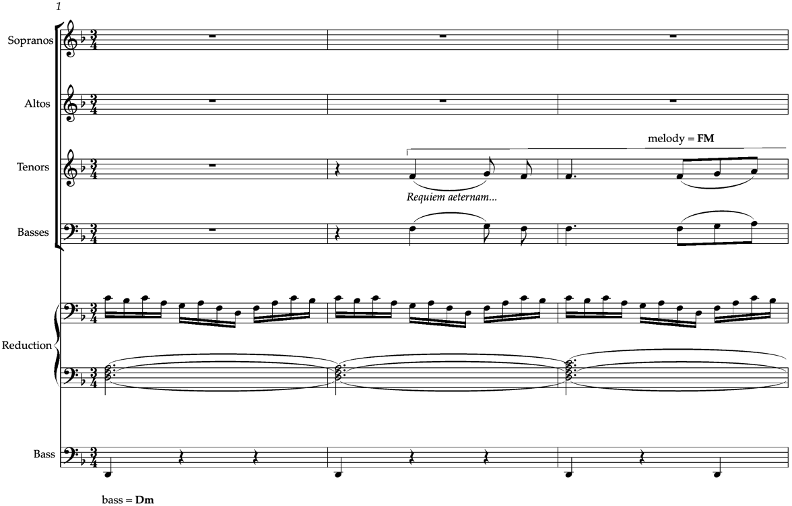
A familiar wash of key duality occurs in the fourth movement, shown in Example 14. Here, though, the interval of disjunction between the two tonal centers is not a third but a second—a G minor bass and F major choir. The constant F major triads at the beginning of each measure rub against the G bass downbeats. The G minor bass materializes with the assistance of the D dominant upbeats and what sounds like a half cadence in G in m. 6. The composite key, if one were to lean toward a monotonal hearing, might be D minor due to the D minor arpeggios which mediate the disjunction of G minor and F major. A possibility for D minor is to hear an out-of-sync iv(add6)-i in D minor, with the G bass connected to the
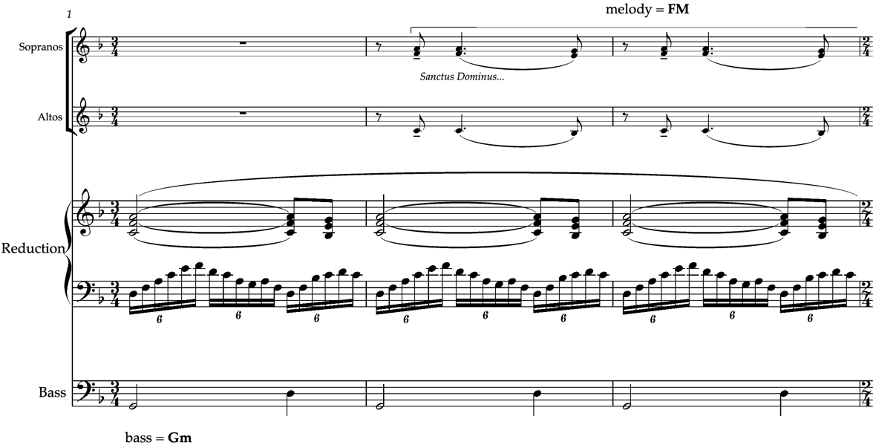
Role of Inner Voices
There is something to be said for how inner voices contribute to a sense of key duality. Example 15, from the second movement of Fauré’s Piano Quintet no. 2, serves as a snapshot of how inner voices bewilder a single-key interpretation. The soprano outlines

Finally, Example 16 from the third movement models how a certain line might nudge the music to a new center or key. Harmonies spring from canonic statements of the motive over mm. 35–39. Trailing a
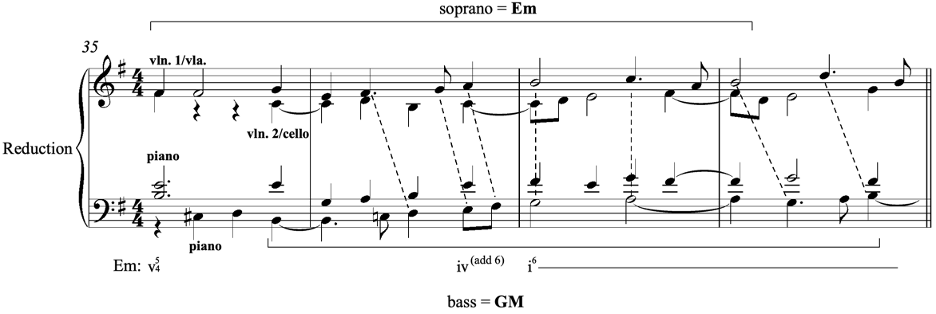
Concluding Thoughts and Directions
In Fauré and Duruflé’s music, key duality often occurs between tonal centers separated by a third. While relations by third are the norm when it comes to tonal pairing and double-tonic complexes, the distinctiveness of their key duality lies in the disjunction, or “divorce,” between a melody and a bass that express dissimilar tonal centers. When related by thirds, these stratified tonal centers often arise via contrapuntal 5–6 exchanges. Finally, the amalgamation of two tonal layers conjures a quintessential modal landscape, often in the form of a tonic seventh chord formed from the union of two tonics. Fauré’s influence on French modernism is well-known, and his use of key duality is magnified in the works of Duruflé. Overall, Duruflé employs it with wider formal breadth and intervals of disjunction beyond a third, as seen in Example 14
Throughout this article, my analyses have espoused a broader attention to individual voices, especially outer ones. Because these chords like the ones in Example 10 are in transit, assigning a clean harmonic label can be challenging and counterproductive. Extoling Fauré’s mastery of counterpoint, James Kurtz (1970) prefers to downplay a vertical chord-by-chord interpretation. He concurs that “root movement is subordinate to the behavior of individual voices” in Fauré and continues: “the means of establishing its [the tonic’s] priority is more often to be found through the use of contrapuntal motions and melodic relationship rather than traditional tonal function [of harmonies]…Most vertical sonorities come into being though a confluence of moving parts” (183).57 In addition, he underscores the autonomous role of the bass as an independent line that partakes in more than root progressions. William Thomson (2006) also argues for melodic agency in progressions: “The pitch simultaneities of chords add an immediate and significant shaping dimension; sometimes they confirm, sometimes they are at odds with melodic shaping” (94).58 Essentially, a chord tone may be consonant with its own triad but dissonant in the larger context of melodic unfolding.
The main thrust of this article has foregrounded outer voices as the sculptor of tonal structure in Fauré and Duruflé; in particular, I have focused heavily on linear utterances and their tonal disjunction. In these pieces, both composers permit the melody and bass to establish their own centers, rendering the impression of two operating keys.59 Although unconventional harmonic syntax and added sevenths baffle straightforward analysis, when we attend to the melody and bass, we notice the source of ambiguity in the form of key duality. The superposition of discrete tonal centers reflects the myriad expanded conceptions of tonality of the twentieth century. Sensitivity to the tonal profile of these outer voices helps reveal the origins of key duality in this perplexing twentieth-century repertoire.
References
Bailey, Robert. 1985. “An Analytical Study of the Sketches and Drafts.” In Richard Wagner: Prelude and Transfiguration from “Tristan and Isolde,” edited by Robert Bailey. New York: Norton.
BaileyShea, Matt. 2007. “The Hexatonic and the Double Tonic: Wolf’s ‘Christmas Rose.’ ” Journal of Music Theory 51, (2 Fall): 187–210.
Bakulina, Ellen. 2018. “Proto-Harmony and The Problem of Tonal Centricity in Rachmaninoff’s All-Night Vigil.” Intégral 32 : 15–36.
— — —. 2014. “The Concept of Mutability in Russian Theory.” Music Theory Online 20 (3). https://www.mtosmt.org/issues/mto.14.20.3/mto.14.20.3.bakulina.php.
Boulanger, Nadia. 1926. “Lectures on Modern Music.” The Rice Institute Pamphlet 13 (2): 113–152.
Brooks, Jeanice. 2016. The Musical Work of Nadia Boulanger: Performing Past and Future Between the Wars. Cambridge University Press.
Caron, Sylvain. 2017. “Écriture tonale et perspectives nouvelles de l’harmonie fauréenne.” Canadian University Music Review 22 (2): 48–76.
Chiu, Matt. 2021. “Macroharmonic Progressions through the Discrete Fourier Transform: An Analysis from Maurice Duruflé’s Requiem.” Music Theory Online 27 (3). https://mtosmt.org/ issues/mto.21.27.3/mto.21.27.3.chiu.html.
Cohn, Richard. 2012. Audacious Euphony: Chromatic Harmony and the Triad’s Second Nature. Oxford University Press.
De Clercq, Trevor. 2019. “The Harmonic-Bass Divorce in Rock,” Music Theory Spectrum 41 (2): 271–284.
Ferrandino, Matthew. 2022 “Multi-Centric Complexes in Pop-Rock Music.” Intégral 35: 27–43.
Greer, Taylor. 1991. “Modal Sensibility in Gabriel Fauré’s Harmonic Language.” Theory and Practice 16: 127–142.
Flint, Catrena. 1997. La Chanson d’Eve: Counterpoint in the Late Style of Fauré. PhD diss., McGill University.
Harrison, Daniel. 2016. Pieces of Tradition: An Analysis of Contemporary Tonal Music. Oxford University Press.
Kaminsky, Peter. 2004. “Ravel’s Late Music and the Problem of ‘Polytonality.’ ” Music Theory Spectrum 26 (3): 237–264.
Klorman, Edward. 2016. Mozart’s Music of Friends: Social Interplay in the Chamber Works. Cambridge: Cambridge University Press.
Kurtz, James. 1970. “Problems of Tonal Structure in Songs of Gabriel Fauré.” PhD diss., Brandeis University.
Moore, Allan. 1995. “The So-Called ‘Flattened Seventh’ in Rock.” Popular Music 14 (2): 185–201.
Nectoux, Jean-Michel. 2004. Gabriel Fauré: A Musical Life. Translated by Roger Nichols. Cambridge University Press.
Nobile, Drew. 2020. “Double-Tonic Complexes in Rock Music.” Music Theory Spectrum 42 (2): 207–226.
— — —. 2015. “Unpacking the ‘Melodic-Harmonic Divorce.” Music Theory Spectrum 37 (2): 189–203.
Pau, Andrew. 2016. “Plagal Systems in the Songs of Fauré and Duparc.” Theory and Practice 41: 81–111.
Phillips, Edward R. 1993. “Smoke, Mirrors and Prisms: Tonal Contradiction in Fauré.” Music Analysis 12 (1): 3–24.
Pomeroy, Boyd. 2004. “Tales of Two Tonics: Directional Tonality in Debussy’s Orchestral Music.” Music Theory Spectrum 26 (1): 87–118.
Rabinovitch, Gilad. 2023. “Reimagining Fauré’s Harmony.” Intégral 36: 55–101.
Rupprecht, Philip. 1996. “Tonal Stratification and Uncertainty in Britten’s Music.” Journal of Music Theory 40 (2): 311–346.
Smith, Peter H. 2013. “Tonal Pairing and Monotonality in Instrumental Forms of Beethoven, Schubert, Schumann, and Brahms.” Music Theory Spectrum 16 (2): 175–217.
— — —. 1997. “Brahms and Motivic 6/3 Chords.” Music Analysis 12 (1): 3–24.
Sobaskie, James. 1999. “Allusion in the Music of Gabriel Fauré.” In Regarding Fauré, edited by Tom Gordon. New York: Gordon and Breach.
Straus, Joseph. 1982. “Stravinsky’s Tonal Axis.” Journal of Music Theory 26 (2): 261-290.
Swinden, Kevin, J. 2005. “When Functions Collide: Aspects of Plural Function in Chromatic Music.” Music Theory Spectrum 27 (2): 249–282.
Tait, Robin C. 1986. “The Musical Language of Fauré.” PhD diss., University of St. Andrews.
Temperley, David. 2007. “The Melodic-Harmonic ‘Divorce’ in Rock.” Popular Music 26 (2): 323–342.
Thompson, William. 2006. “Pitch Frames as Melodic Archetypes.” Empirical Musicology Review 1 (2): 85–102.
Thompson William and Shulamit Mor. 1992. “A Perceptual Investigation of Polytonality.” Psychological Research 54: 60-71.
Vuillermoz, Émile. 1969. Gabriel Fauré. Translated by Steven Smolian. Chilton Book Co..
Notes
- When speaking of the accompaniment versus the melody, I mean the accompaniment with the bass unless stated otherwise. However, as we will see, inner voices can support the tonal center of the melody, bass, or both.
- One might also consider these relationships as neo-Riemannian R or L transformations.
- In her earlier work on Russian music, Bakulina (2014) culls the nuances of mutability—a uniquely Russian construal of key duality.
- See Straus (1982), who shares an example from the Symphony of Psalms where the E minor and G major triads appear simultaneously as an arpeggio. However, BaileyShea (2007) points out that Straus never calls this fusion of triads a “tonic” (BaileyShea, 196).
- For instance, in the second movement of Fauré’s Violin Sonata no. 2, the opening theme teeters between A major (I) and C$$\sharp$$ minor (iii) due to the C$$\sharp$$-D$$\sharp$$-E melodic statements.
- The aural perceptibility of polytonality has been long contested. Thompson and Mor (1992) admit that in the face of two competing tonal centers (“textures”), the listener elects one, declaring the other “ineffective”—a source of dissonance in the principal key.
- A key implies a general network of tonal associations oriented around a “single, maximally stable pitch class” (Nobile 2020, 209).
- BaileyShea’s primary task is to connect the D major and F$$\sharp$$ minor duality of the music to the poetic text in Wolf’s Auf eine Christblume.
- In the latter sense, category two shares features with category three.
- Certain moments of the D/F$$\sharp$$ double-tonic complex in BaileyShea’s analyses are incredibly isolated. For instance, he labels a lower-level, contrapuntal D augmented triad as a manifestation of a D major and F$$\sharp$$ major complex. Elsewhere, he describes a D minor chord—passing in the middle of an omnibus progression—as an “especially poignant” moment of the D/F$$\sharp$$ complex. Thus, for BaileyShea, instances of the double-tonic complex may be quite local, even lasting for two beats within “more conventional linear patterns” (201).
- Nobile explicates the distinction between tonal pairing and the double-tonic complex by comparing the two to linguistic ambiguity and linguistic indeterminacy, respectively. The former entails a “semantic problem in need of a solution,” such as the cognitive confusion between two homographs, like the word “bear,” while the latter simply conveys “vagueness or generality” but still gets the semantic meaning across (222–24).
- In his expert justification of the double-tonic complex, Nobile does not ignore experiential interpretations and cites “rapid reorientations from hearing one center to the other” (216).
- Kaminsky (2004) points out that Ravel’s tendency to use “unresolved” appoggiaturas is an example of the first category, where the bass subsumes the treble voices under its tonal purview. Kaminsky’s idea of strata prioritization is pertinent to this study; turning attention to either the bass or soprano may shade listening.
- Rupprecht shows how these discrete pitches, especially in the lower register, can still imply a tonal, or harmonic, structure.
- Both Kaminsky and Rupprecht take Milhaud’s idea of polytonality as a point of departure but apply it to their work quite differently.
- Allan Moore (1995) coined the term melodic-harmonic divorce. De Clercq (2019) notes that Moore recognized three “functional layers” in pop and rock: bass, melody, and harmony.
- De Clercq (2019) reworks Nobile’s categories of melodic-harmonic divorce to fashion his categories of harmonic-bass divorce.
- Divorce in popular music often refers explicitly to divorce of function; see, for example, Drew Nobile (2015).
- Nobile (2020) also calls attention to the harmonic corollary of two tonal strata. As mentioned earlier, he shows how an A minor bass line and C major vocal line produce a four-note “tonic” sonority at the beginning of the chorus in Hall and Oates’ “Private Eyes.” As the generative tonic of a true double-tonic complex, neither A minor nor C major is “structurally superior” to the other (Nobile 2020, 210).
- Although Klorman does not analyze tonal layers, his work on musical agency in classical music grapples (quite abstractly) with how listeners interpret the dynamic dialogue of a string quartet.
- The presence of key duality from melody or bass disjunction may have been a symptom of Fauré’s auditory issues, which drastically distorted his pitch perception. According to Nectoux (2004), Fauré “heard bass notes a third higher and treble notes a third lower” (293). Nectoux quotes Fauré as early as 1907 lamenting his faulty hearing. Listening to his compositions after he wrote them was particularly cruel for this reason, as described by Catrena Flint (1997, 3–4). Fauré was known to compose away from the piano as a result.
- See Tait (1986). Tait also identifies more major chords with added sixths during Fauré’s late period (Tait, 64–65).
- This is, admittedly, a dualist reading. Pau (2016) cites dualist perspectives from Cohn and d’Indy, the latter of which “mediated” the dualist teachings of Riemann in France (Pau, 84).
- If the bass line articulates a traditional stock segment, such as $$\hat{1}$$-$$\hat{6}$$-$$\hat{4}$$-$$\hat{5}$$ or $$\hat{1}$$-$$\hat{4}$$-$$\hat{5}$$-$$\hat{1}$$, we may hear it as confirming its own key even without the supporting upper voices. Gilad Rabinovitch (2023), for instance, states that “Fauré tends to use the ‘wrong’ triads or seventh chords above conventional tonal bass schemata” (64). In other words, these “tonally disorientating upper-voice structures, often $$^{6}_{3}$$ substitutions,” bewilder the key expressed by the bass (83).
- If the bass has a dissonance (e.g., chordal seventh) that foregoes typical resolution, context will determine if it is a non-chord tone or a fundamental dissonance.
- Likewise, Fauré reverses traditional tonal practice whenever he opts for plagal gestures over authentic gestures. For an in-depth dive into allusion in Fauré, see James Sobaskie (1999). He identifies three forms of allusion: tonal implication, transient tonicization, and modal suggestion. The first refers to “the allusion to elements of tonal voice-leading structure, either absent, forthcoming, or already past” (163–205). All Sobaskie’s forms of allusion occur in Fauré due to unique doublings or voicings that de-center tonal practices, such as stressing the chordal third or fifth rather than the root, as mentioned above.
- Émile Vuillermoz (1969) states that the bass acted as a “generating cell for a harmonic creation” for Fauré (Vuillermoz, 102). In fact, Fauré often asked for strong articulation of the bass during lessons. His gravitation toward bass lines may be related to familiarity with the organ’s foot pedal.
- The difference in rationalizing away a disparate tonal layer as simply embellishing a primary key lies in the significance of its linear presentation. Fauré’s admirer, Nadia Boulanger, mourned the propensity for vertical interpretations, lamenting that “we have more or less lost the art of listening to contrapuntal music of following lines rather than chords” (Brooks 2016, 56). Turning our attention to the tonal profile of lines can tell us much about the perplexing chords that result from them.
- In contrast, common-practice music exhibits inner voices working with the bass in conveying a single center or key.
- Often the tonic and the fifth are unchanged but the other notes of the scale/collection are varied. See James Kurtz (1970). Kurtz observes how a foreground harmony serves simply to harmonize a melodic note with a consonant chord. For example, in G major, an F major chord might support a C in the melody.
- Admittedly, pitch centricity around G is so strong that some listeners may hear G minor as the tonal center of the melody. Because Fauré presents the melody in C minor earlier (mm. 35–40), I hear it in C minor, although melodic emphasis of $$\hat{5}$$ is prominent throughout his oeuvre.
- Although the D scale is phrygian with E$$\flat$$, pitches of the D minor triad are unchanged. In later pieces, Fauré preserves structural pitches of a melody, such as $$\hat{1}$$ and $$\hat{5}$$, but drastically alters the “in-between” notes. See the third movement of the Piano Quintet No. 2, mm. 1–9 (not shown), where the tonic and dominant pitches are intact while other notes of the diatonic collection are varied until the cadence.
- His analyses embrace a more prolongational attitude rooted in the style of Schenker.
- Stepwise bass lines are ubiquitous in Fauré and account for much difficulty in extracting a functional bass line due to their contrapuntal nature.
- Smith (1997) questions whether the voice-leading exchange from the fifth of a chord (I) to its sixth creates a new harmony (vi) or not. He unpacks two types of $$^{6}_{3}$$ substitutions: those that commence via 5–6 motion and those that are simply triads in first inversion. In general, he explores how this procedure might be executed on the tonic triad, therefore blurring the boundary between tonic and submediant. Although Smith does not comment on key duality, he nonetheless shows how these $$^{6}_{3}$$ substitutions could account for an essence of key duality between the tonic and submediant (Smith, 191).
- As Rabinovitch shows, the RO may have been fresh in Fauré’s mind as part of the partimenti tradition. Partimenti considered bass harmonization in very localized terms. Such view is antithetical to many theories seeking to champion long-range tonal coherence. Hence, it may be tougher to detect substitutions along the RO in these short segments and judge how they might contribute to key duality. Nevertheless, we have a delightful “position finding game along the RO” which encourages us to reflect on possible tonal directions (Rabinovitch, 73).
- The I-iii sidestep via $$\sharp\hat{4}$$ is a staple of Fauré’s oeuvre. It shows up earlier in mm. 46–47, when D$$\natural$$ carries the music from A$$\flat$$ major to C minor. Overall, the shift to iii is often a case of the sixth in a I$$^{6}$$ sliding down a half step to the leading tone.
- A similar instance of duality between G minor and E$$\flat$$ major, caused by the substitution of the pitch D for E$$\flat$$, appears in the second movement of the Piano Quintet no. 2 in mm. 107–120.
- Frequently, reading a motive separately from the harmony—not together as a complete entity—can expose a separate tonal layer. Recognizing motive and harmony as two separate musical forces, cooperating only occasionally, may also explain why various harmonic notes do not behave as expected. In the presence of harmonic dissonances (like added sevenths), it is wise to consider the melody and accompaniment separately to explain tendency tones that do not resolve traditionally; there may be two rivaling tonal centers.
- Granted, one may hear the tonicization of F$$\sharp$$ minor now as part of a D major/F$$\sharp$$ minor complex. I tend to perceive the F# minor as a minor dominant (v) in B minor, albeit “super-charged,” due to its earlier B minor context and the following F$$\sharp$$-D leap which had occurred before.
- James Kidd (1973) explores how nineteenth-century chant accompaniment played a role in Fauré’s proclivity for modalism. Taylor Greer (1991), when speaking of Fauré’s “modal” language, refers explicitly to modal mixture and how flat mediants or flat submediants function within the confines of traditional syntax.
- For a richer investigation of plural harmonic function, see Kevin Swinden (2005). When faced with a problematic passage, we would do well to see if melodic resolutions do or do not correspond with harmonic ones; for example, the D tonic arrival in m. 12 is complicated by a G wedged in the bass—a clear case of tonal disjunction.
- Like Example 4, the members of the E$$\flat$$ tonic triad are fixed despite the momentary Lydian inflection in m. 123. See also Example 15.
- I have assimilated the G minor alto melody into the C minor/E$$\flat$$ major realm of the outer voices. However, the pianist might experiment bringing out this line for fun during rehearsal.
- The D$$^{7}$$ is preceded by a six-measure D major harmony. Measure 128 begins a sequence upward that transports the music to G major (V of C minor).
- The G$$\sharp$$s in the inner voice resolve to A, the reciting tone of both F major (mode 6) and D minor (mode 1). I am grateful for the anonymous reviewer that brought this to my attention.
- Harrison (2016) notes the preponderance of conflated tonics in French Impressionism. Chiu (2021) positions his analysis along mathematical lines, using the discrete Fourier transform (DFT) to explain octatonic and hexatonic shifts.
- Typical of Duruflé’s works, the cadence in the melody precedes the cadence in the accompaniment.
- The final of the chant often ends a third above the root of the harmony; in the fifth movement, “Pie Jesu,” the voices conclude by repeating the C final over an A$$\flat$$ major triad.
- The Introit of Fauré’s Requiem also brandishes duality between F major and D minor. For a transformational reading of this work, see Cohn (2012, 54–56).
- A varied statement of the mm. 8–11 melodic line occurs over mm. 16–19, but the vocal ending on F is harmonized with an F major triad this time after a plagal cadence (not shown).
- The orchestra cadences in m. 56, but the voice does not cadence on F until m. 58. In fact, contrapuntal motion in the choir often evades what would otherwise be a closed cadence in the bass, and vice versa. See, for instance, the second and fifth movements.
- In the Introit, the F final is harmonized with an F major triad; in the Sanctus, the D final is harmonized with a D minor triad.
- The lydian A$$\natural$$ does not destroy the impression of E$$\flat$$, nor the fact that C$$\sharp$$-D would make more sense as scale degrees $$\sharp$$4-5 rather than $$\sharp$$6-7. On the other hand, hearing C$$\sharp$$-D as $$\sharp\hat{4}$$-$$\hat{5}$$ underscores the sway of G minor.
- The G phrygian motion of the alto (A$$\flat$$-G in mm. 1–2) is echoed in the E$$\flat$$ phrygian of the soprano (E$$\flat$$-F$$\flat$$ in mm. 3–4).
- The C$$\sharp$$ of m. 35 aside, the bass outlines G major with parallel tenths above, inserting an element of key duality within the overarching E minor.
- Certainly, the plethora of unresolved dominant sevenths in the accompaniment points the listener to another potential source of tonal coherence: the melody.
- He demonstrates how conflict between foreground and background harmonic structures steers two different interpretations—oriented toward the foreground or middleground—that may not be reconciled into one. While middleground and larger level structures are beyond the scope of this paper, these authors praise the importance of outer voices for clarifying structure. Philips (1993) also pays close attention to contrapuntal lines. In one case, he cites “counterfeit dominants” that contradict the middleground—dominants that function locally but not structurally as dominants (Phillips, 7). The proliferation of seventh chords places a “smokescreen” over the middleground structure, obfuscating or denying it.
- There are many cases where the bass does not express a harmonic unfolding. In the absence of a tonal profile, we may look to the soprano for a center or key.
